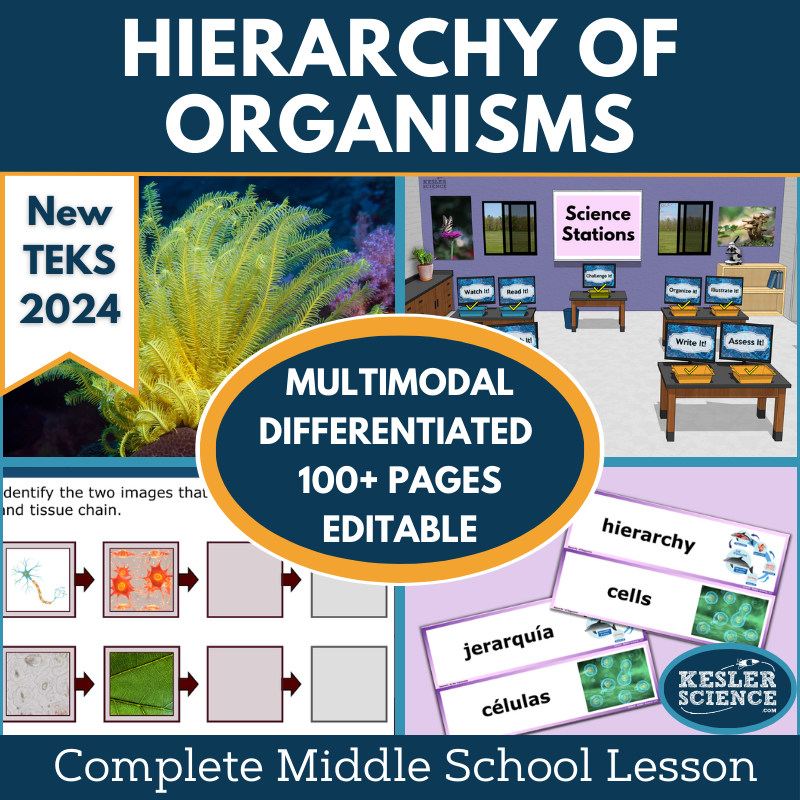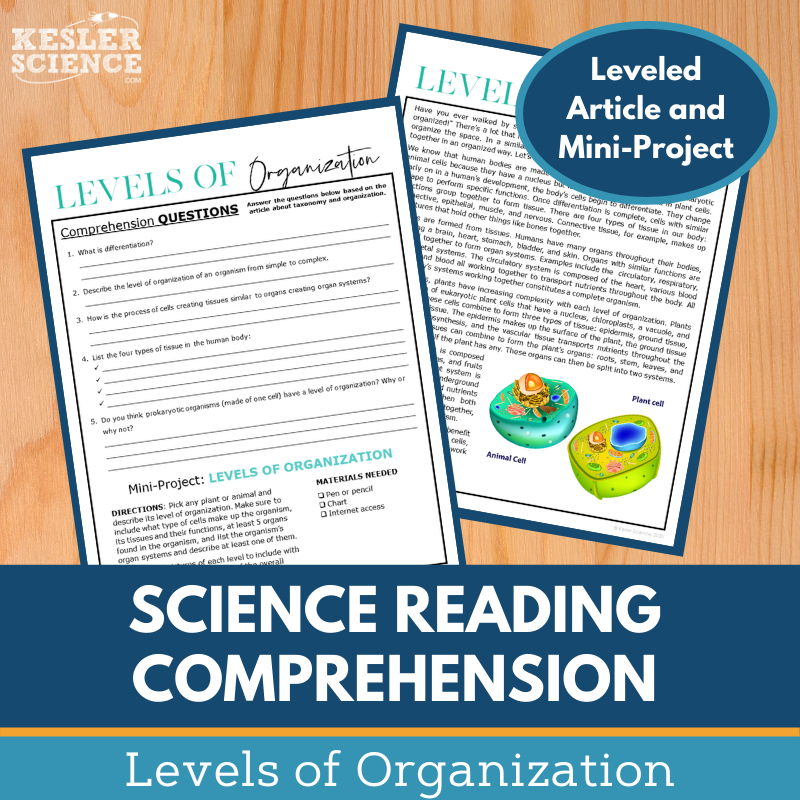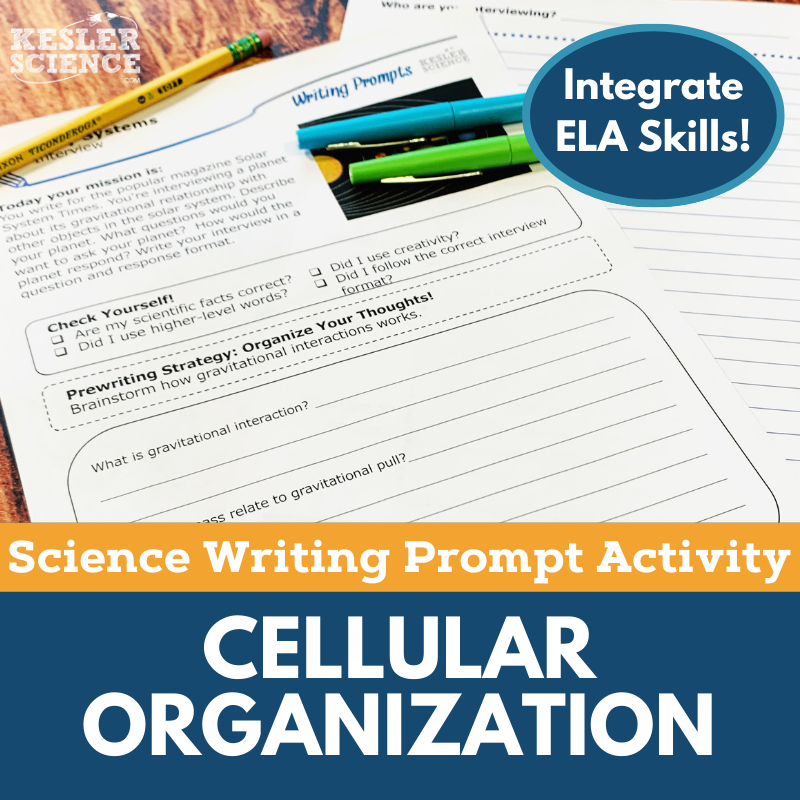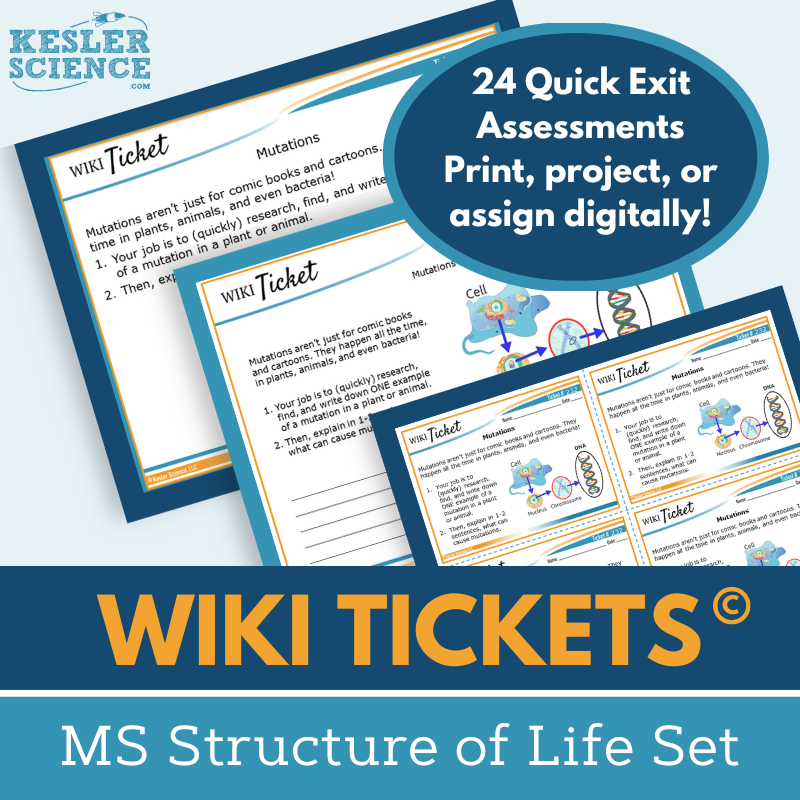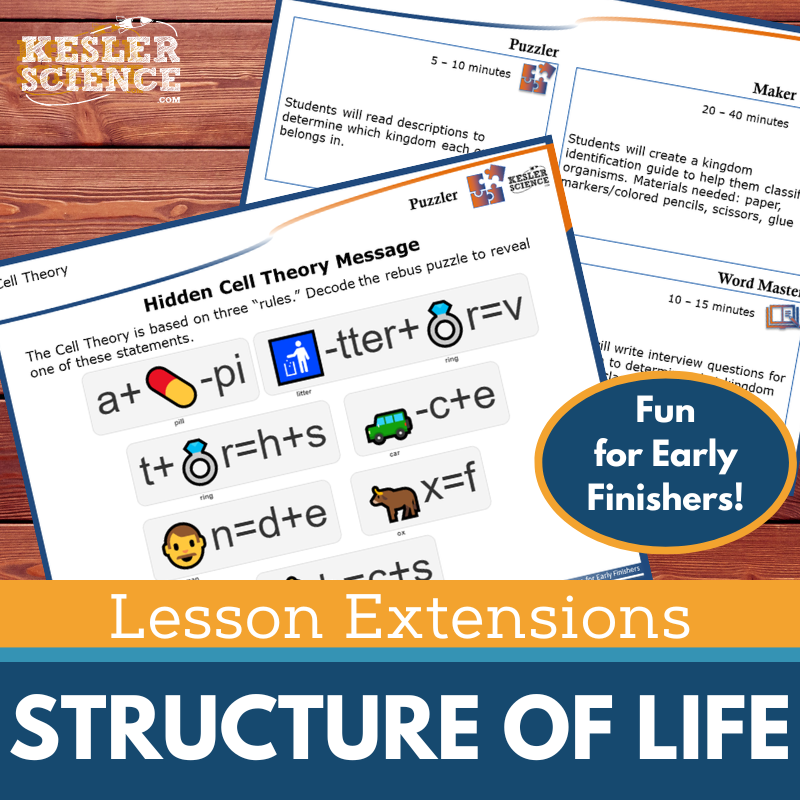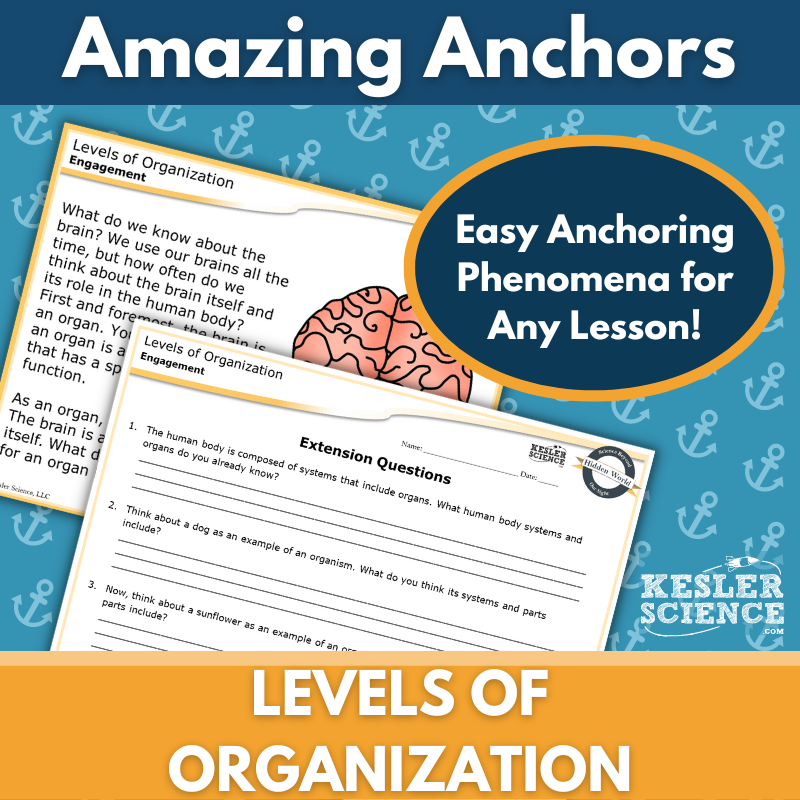Hierarchy of Organisms Activities for Middle School Science
The Kesler Science Hierarchy of Organisms 5E Lesson helps students explore the organization of cells, tissues, organs, and organ systems in plants and animals. The resources below will give students a comprehensive understanding of the hierarchy of organisms. All of the following materials are also included in the Kesler Science Membership.
The Kesler Science Hierarchy of Organisms 5E Lesson is a comprehensive, student-led unit covering the organization of cells, tissues, organs, and organ systems in plants and animals. It includes editable presentations, worksheets, choice projects, and assessments, all designed for differentiated, multimodal learning. Fully aligned with TEKS 7.13B, the lesson provides both printable and digital formats, with Spanish translations for key materials.
Following the 5E Model, the unit begins with engaging discussions and activities. Students then explore the topic through a differentiated station lab with nine stations, incorporating hands-on activities, reading passages, research, videos, and interactive exercises. Explanation is reinforced with editable PowerPoints, interactive notebooks, and note-taking templates in both English and Spanish. Students elaborate on their understanding through choice projects that highlight the structure and function of organ systems. The lesson concludes with STAAR 2.0-aligned assessments, review questions, and worksheets for evaluation.
Flexible for in-class or virtual learning, this unit ensures that all students can engage with the material in ways that suit their learning styles while allowing teachers to focus on student success.
The Kesler Science Hierarchy of Organisms 5E Lesson is a comprehensive, student-led unit covering the organization of cells, tissues, organs, and organ systems in plants and animals. It includes editable presentations, worksheets, choice projects, and assessments, all designed for differentiated, multimodal learning. Fully aligned with TEKS 7.13B, the lesson provides both printable and digital formats, with Spanish translations for key materials.
Following the 5E Model, the unit begins with engaging discussions and activities. Students then explore the topic through a differentiated station lab with nine stations, incorporating hands-on activities, reading passages, research, videos, and interactive exercises. Explanation is reinforced with editable PowerPoints, interactive notebooks, and note-taking templates in both English and Spanish. Students elaborate on their understanding through choice projects that highlight the structure and function of organ systems. The lesson concludes with STAAR 2.0-aligned assessments, review questions, and worksheets for evaluation.
Flexible for in-class or virtual learning, this unit ensures that all students can engage with the material in ways that suit their learning styles while allowing teachers to focus on student success.
This student-led station lab aligns with TEKS 2021 standard 7.13B, engaging middle school students in learning about the hierarchical organization of cells, tissues, organs, and organ systems in plants and animals. Designed for in-class or virtual settings, the lab features nine modular, differentiated stations that promote active, independent learning.
Students will explore concepts through various activities, including reading passages, watching videos, and conducting research. Stations like Explore It! offer hands-on applications, while Watch It! and Read It! help students engage with content through multimedia and text. The Research It! station provides additional resources, including images and graphs, for deeper understanding.
The lab also includes Organize It!, where students use manipulatives to create models, and Illustrate It!, where they sketch or draw representations of the hierarchical structure. Write It! allows students to articulate their understanding through written responses and Assess It! challenges them with questions to test their knowledge. A bonus station, Challenge It!, provides extension activities for advanced learners, including games and mini-projects.
This flexible, low-prep resource encourages student ownership of learning while meeting the diverse needs of the classroom.
Thise student-led station lab aligns with TEKS 2021 standard 7.13B, engaging middle school students in learning about the hierarchical organization of cells, tissues, organs, and organ systems in plants and animals. Designed for in-class or virtual settings, the lab features nine modular, differentiated stations that promote active, independent learning.
Students will explore concepts through various activities, including reading passages, watching videos, and conducting research. Stations like Explore It! offer hands-on applications, while Watch It! and Read It! help students engage with content through multimedia and text. The Research It! station provides additional resources, including images and graphs, for deeper understanding.
The lab also includes Organize It!, where students use manipulatives to create models, and Illustrate It!, where they sketch or draw representations of the hierarchical structure. Write It! allows students to articulate their understanding through written responses and Assess It! challenges them with questions to test their knowledge. A bonus station, Challenge It!, provides extension activities for advanced learners, including games and mini-projects.
This flexible, low-prep resource encourages student ownership of learning while meeting the diverse needs of the classroom.
The Hierarchy of Organisms Student Choice Projects align with the 2021 TEKS standard 7.13B and offer middle school students multiple ways to demonstrate their learning. A project page presents six student-led project options, along with a “design your own” project. An editable rubric allows assessments by teachers, peers, or students.
These flexible, multimodal projects allow students to select creative ways to showcase their understanding. Teachers can adapt the rubric as needed for grading. There are two versions of the project page: a modified version for students needing remediation and a challenge version for advanced learners.
Standard classroom supplies like paper, markers, and scissors are all that's needed, and many projects can be completed digitally.
The Hierarchy of Organisms Student Choice Projects align with the 2021 TEKS standard 7.13B and offer middle school students multiple ways to demonstrate their learning. A project page presents six student-led project options, along with a “design your own” project. An editable rubric allows assessments by teachers, peers, or students.
These flexible, multimodal projects allow students to select creative ways to showcase their understanding. Teachers can adapt the rubric as needed for grading. There are two versions of the project page: a modified version for students needing remediation and a challenge version for advanced learners.
Standard classroom supplies like paper, markers, and scissors are all that's needed, and many projects can be completed digitally.
This TEKS-aligned lab helps students understand how cells, tissues, organs, and organ systems work together in organisms. It includes three differentiated labs to support diverse learning needs: a dependent lab with guided inquiry for on-level learners, a modified lab with structured instructions for learners requiring modifications, and an independent lab for advanced students that fosters more student-centered exploration.
The lab includes editable teacher resource pages with prep time, standards, materials, and additional resources. It also features answer keys, CER (Claim, Evidence, and Reasoning) questions, and reflection prompts for each lab. Key materials include a resource sheet, label page, template pages (for the modified level), scissors, tape, beads, and pipe cleaners. The tissue sample sheets can be printed, laminated, and reused for multiple sessions.
Aligned to TEKS and NGSS, this lab offers a comprehensive, hands-on approach for understanding biological systems.
This TEKS-aligned lab helps students understand how cells, tissues, organs, and organ systems work together in organisms. It includes three differentiated labs to support diverse learning needs: a dependent lab with guided inquiry for on-level learners, a modified lab with structured instructions for learners requiring modifications, and an independent lab for advanced students that fosters more student-centered exploration.
The lab includes editable teacher resource pages with prep time, standards, materials, and additional resources. It also features answer keys, CER (Claim, Evidence, and Reasoning) questions, and reflection prompts for each lab. Key materials include a resource sheet, label page, template pages (for the modified level), scissors, tape, beads, and pipe cleaners. The tissue sample sheets can be printed, laminated, and reused for multiple sessions.
Aligned to TEKS and NGSS, this lab offers a comprehensive, hands-on approach for understanding biological systems.
In this lesson, students explore the levels of organization in plants and animals by reading a nonfiction article on cells, tissues, organs, organ systems, and organisms. They then complete comprehension questions and a graphic organizer about the levels of organization in a chosen organism.
Designed for middle school students (grades 6-8), the resource includes two leveled articles with Lexile levels of 1100-1300. Activities feature 5-7 comprehension questions, a hands-on mini-project, and a Cornell notes template. The article is accompanied by engaging graphics that can be printed in grayscale.
This resource is suitable for both in-person and virtual learning environments, with compatibility for platforms like Google Classroom, MS Teams, Schoology, and Canvas. It can be used for absent students, extra credit, sub plans, or whole-class instruction. Teachers can incorporate it into lessons to build science literacy, enhance reading comprehension, and promote classroom discussions.
In this lesson, students explore the levels of organization in plants and animals by reading a nonfiction article on cells, tissues, organs, organ systems, and organisms. They then complete comprehension questions and a graphic organizer about the levels of organization in a chosen organism.
Designed for middle school students (grades 6-8), the resource includes two leveled articles with Lexile levels of 1100-1300. Activities feature 5-7 comprehension questions, a hands-on mini-project, and a Cornell notes template. The article is accompanied by engaging graphics that can be printed in grayscale.
This resource is suitable for both in-person and virtual learning environments, with compatibility for platforms like Google Classroom, MS Teams, Schoology, and Canvas. It can be used for absent students, extra credit, sub plans, or whole-class instruction. Teachers can incorporate it into lessons to build science literacy, enhance reading comprehension, and promote classroom discussions.
The Cellular Organization Science Writing Prompt Activity engages middle school students in a creative, song-based writing exercise to deepen their understanding of cellular organization in plants and animals. Aligned with TEKS, the activity helps students recognize the levels of organization from cells to organisms. The resource supports both in-person and virtual learning, ensuring that students remain engaged outside the classroom.
The activity includes teacher directions with an answer guide, project ideas, and rubrics, as well as projection and print versions of the writing prompt. Full-sized and half-sheet handouts provide students with a pre-writing strategy, self-check, and layout template. Additionally, a digital interactive version is available, easily adaptable for Google Slides. The resource is perfect for cross-curricular activities, pre-tests, student projects, and differentiation exercises, and can be used for extra credit, make-up work, or TELPAS samples.
The Cellular Organization Science Writing Prompt Activity engages middle school students in a creative, song-based writing exercise to deepen their understanding of cellular organization in plants and animals. Aligned with TEKS, the activity helps students recognize the levels of organization from cells to organisms. The resource supports both in-person and virtual learning, ensuring that students remain engaged outside the classroom.
The activity includes teacher directions with an answer guide, project ideas, and rubrics, as well as projection and print versions of the writing prompt. Full-sized and half-sheet handouts provide students with a pre-writing strategy, self-check, and layout template. Additionally, a digital interactive version is available, easily adaptable for Google Slides. The resource is perfect for cross-curricular activities, pre-tests, student projects, and differentiation exercises, and can be used for extra credit, make-up work, or TELPAS samples.
These 6th-8th grade science formative assessments offer flexible, engaging ways to check student understanding across a range of topics. The Structure of Life Set includes 24 WIKI Tickets© assessments, with each topic available in five formats: a full-screen display for projection, three handout versions (full, split, and quarter-page), and an interactive version compatible with PowerPoint or Google Slides for digital use.
Aligned with NGSS and TEKS standards, the set covers various topics, including cell theory, heredity, homeostasis, CRISPR, mutations, and more. Some topics have multiple tickets, and all standards are addressed with at least one ticket. A bonus table of contents file shows alignment for easy reference.
These assessments are designed for use both in-person and virtually, making them versatile for any learning environment. Whether used as exit tickets, bellringers, or quick checks, they provide a fun, effective way to gauge student progress.
These 6th-8th grade science formative assessments offer flexible, engaging ways to check student understanding across a range of topics. The Structure of Life Set includes 24 WIKI Tickets© assessments, with each topic available in five formats: a full-screen display for projection, three handout versions (full, split, and quarter-page), and an interactive version compatible with PowerPoint or Google Slides for digital use.
Aligned with NGSS and TEKS standards, the set covers various topics, including cell theory, heredity, homeostasis, CRISPR, mutations, and more. Some topics have multiple tickets, and all standards are addressed with at least one ticket. A bonus table of contents file shows alignment for easy reference.
These assessments are designed for use both in-person and virtually, making them versatile for any learning environment. Whether used as exit tickets, bellringers, or quick checks, they provide a fun, effective way to gauge student progress.
Lesson Extensions provide engaging, student-choice activities to challenge fast finishers and promote critical thinking. These activities help fill downtime, reduce distractions, and offer fun, rigorous learning opportunities. They also support deeper learning for students ready to explore life science topics beyond the basics, aligning with NGSS and TEKS standards.
Each extension includes four key activities: Puzzler for problem-solving, Maker Space for hands-on STEAM projects, Tech Connection for digital demonstrations, and Word Master for creative writing. Teacher directions and answer keys are provided, along with both digital and print versions for easy classroom use.
These extensions are perfect for independent learners and work well for lesson wrap-ups or filling gaps during testing. Topics covered include artificial selection, body systems, cells, genetic mutations, heredity, levels of organization, and more, all tied to life science standards.
Lesson Extensions provide engaging, student-choice activities to challenge fast finishers and promote critical thinking. These activities help fill downtime, reduce distractions, and offer fun, rigorous learning opportunities. They also support deeper learning for students ready to explore life science topics beyond the basics, aligning with NGSS and TEKS standards.
Each extension includes four key activities: Puzzler for problem-solving, Maker Space for hands-on STEAM projects, Tech Connection for digital demonstrations, and Word Master for creative writing. Teacher directions and answer keys are provided, along with both digital and print versions for easy classroom use.
These extensions are perfect for independent learners and work well for lesson wrap-ups or filling gaps during testing. Topics covered include artificial selection, body systems, cells, genetic mutations, heredity, levels of organization, and more, all tied to life science standards.
This Amazing Anchors phenomenon lesson introduces systems in organisms through two engaging readings. The first reading centers around the human brain, with comprehension and extension questions to set the stage for deeper learning. The second reading explains the levels of organization within organism systems, making complex science concepts accessible. Additional questions reinforce understanding and extend student learning.
Aligned with TEKS, this resource includes teacher directions, answer keys, and extra resources. It’s available in both print and digital formats, with full-page slides for projection, editable PPTs for LMS platforms, and handouts for interactive notebooks. The lesson is differentiated, offering a modified version with sentence starters to support students’ comprehension. This resource is designed to complement any lesson on systems in organisms, making it a flexible tool for both in-person and distance learning environments.
This Amazing Anchors phenomenon lesson introduces systems in organisms through two engaging readings. The first reading centers around the human brain, with comprehension and extension questions to set the stage for deeper learning. The second reading explains the levels of organization within organism systems, making complex science concepts accessible. Additional questions reinforce understanding and extend student learning.
Aligned with TEKS, this resource includes teacher directions, answer keys, and extra resources. It’s available in both print and digital formats, with full-page slides for projection, editable PPTs for LMS platforms, and handouts for interactive notebooks. The lesson is differentiated, offering a modified version with sentence starters to support students’ comprehension. This resource is designed to complement any lesson on systems in organisms, making it a flexible tool for both in-person and distance learning environments.
Year-Round Resources
These year-round activities will increase your students' understanding of many middle school science topics. All of these activities are also included in the Kesler Science Membership.
Visual Data & Graphing
You're not alone if your students struggle with understanding graphs, charts, and tables. It's a skill that takes an enormous amount of practice. This resource will help students build a strong foundation in analyzing data and creating their own data visualizations.
Bell Ringers and Warm-Ups
These middle school science bell ringers are an excellent way to engage your students as soon as they walk into your classroom. This comprehensive FULL YEAR resource includes everything you need to start off each science class with an interesting warm-up activity.
Review Board Games
Each game board has been carefully designed to keep students engaged. There are 10 different action spaces on each board and dozens of question cards. All of the actions are related to science concepts and keep the students motivated throughout the game.
Each game is ready to play. Simply print out the board and the cards and let the students enjoy reviewing nine different units.
Essential Questions and Standards
Below are the essential questions and standards associated with the lessons and activities included in the atoms unit. This topic is only one of more than 100 middle school science topics included in the Kesler Science Membership.
-
What is the hierarchical organization within plants and animals?
-
How is the hierarchical organization within plants and animals similar and different?
-
TEKS Science - 7.13B Hierarchy of Organisms
Kesler Science Membership
Imagine never having to search for another middle school science lesson again. The membership gives you access to ALL of the Kesler Science products in one place (Yes, including everything above).
Say goodbye to long hours of lesson prep.

